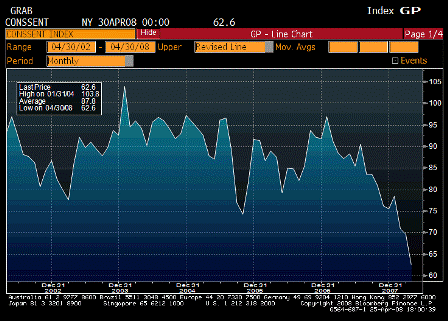U. of Michigan Confidence (Apr F)
| Survey | 63.2 |
| Actual | 62.6 |
| Prior | 63.2 |
| Revised | n/a |
From Karim:
Even weaker than expected at 62.6 vs initial estimate of 63.2.
5-10yr inflation expectations move to higher end of recent range from 3.1% to 3.2%
Following changes from March to April:
- Personal finances 93 to 86
- Buying conditions for durable goods 124 to 112
- 12mth economic outlook 46 to 40
Comments below from Survey itself:
- The Expectations Index, a component of the Index of Leading Economic Indicators, fell by 11.3% from March, by 21.7% from
January of 2008, and by 39.2% from its January 2007 peak. While that steep falloff indicated a recession even before the latest
decline, the accelerated pace of the decline points toward a longer and potentially deeper downturn. Although the tax rebate
will boost spending temporarily, the global rise in food and fuel prices, the declines in home values, and changes in credit
conditions are likely to persist for some time and lengthen the period of stagnation in consumption. Coupled with weaker job
and income growth, these factors have the potential to cause deeper cutbacks in consumption than now anticipated.
- Never before in the long history of the surveys have so many consumers reported hearing news of unfavorable economic
development as in the April survey. The most commonly heard news was about job losses, rising prices, and the fallout from
the housing and credit crisis. Nearly nine-in-ten consumers thought that the economy was now in recession. When asked
about prospects for the economy during the year ahead, three-in-four consumers expected bad times financially, the highest
proportion since 1980.
- Long term inflation expectations rose slightly to 3.2% in April from 2.9% in March and 3.1% in April 2007. Unlike the inflationary era of the
1970’s, when nearly all prices posted persistently large increases, the recent increase in inflation has been dominated by fuel
and food prices. It would take significant and prolonged increases in interest rates to quell the impact of the global rise in food
and fuel prices on domestic inflation, increases that may not be either politically possible nor economically justified.
- Uncertainty about future income and job prospects has had a devastating impact on buying plans, with consumers citing these
uncertainties three times as frequently as they did a year ago. Purchase plans for furniture, appliances, home electronics, and
similar goods fell to their lowest level since the early 1980s, with one-third of all consumers specifically mentioning their
uncertainty about jobs and incomes as their primary reason. Vehicle buying plans also fell to their lowest level since the 1990
recession, with one-third of all consumers citing uncertainty about jobs and incomes as well as the future price of gasoline.
Good report, agreed with all.
A few added comments.
This is a revision of a number has already been out for a while, so it should already be mostly discounted by the markets.
Mainstream economics (not me) would argue that while high food and energy prices are external negative supply shocks, and initially ‘relative value stories’ the Fed has to be careful not to ‘accommodate’ them with low interest rates that support demand as that can cause inflation expectations to elevate and turn a relative value story into an inflation story.
Additionally, mainstream economics assets that low inflation is a necessary condition for optimal long term growth and employment. And while the cost of bring down inflation now may be high, the cost of letting inflation expectations elevate and bringing down inflation later is much higher.
In fact, some in the mainstream argue that had the Fed not supported demand with rate cuts beginning back in August, the cost in lost output to bring inflation back down would have been far lower than the cost to bring it down now after inflation expectations have started to elevate.
It remains to be seen where the Fed stands on this. So far they have been willing to let inflation expectations begin to rise as they focused on keeping the US downturn to a minimum in the face of perceived systemic risk.
Markets are now pricing in the end of rate cuts even as weakness persists, in anticipation of the Fed having reached its tolerance for inflation.

